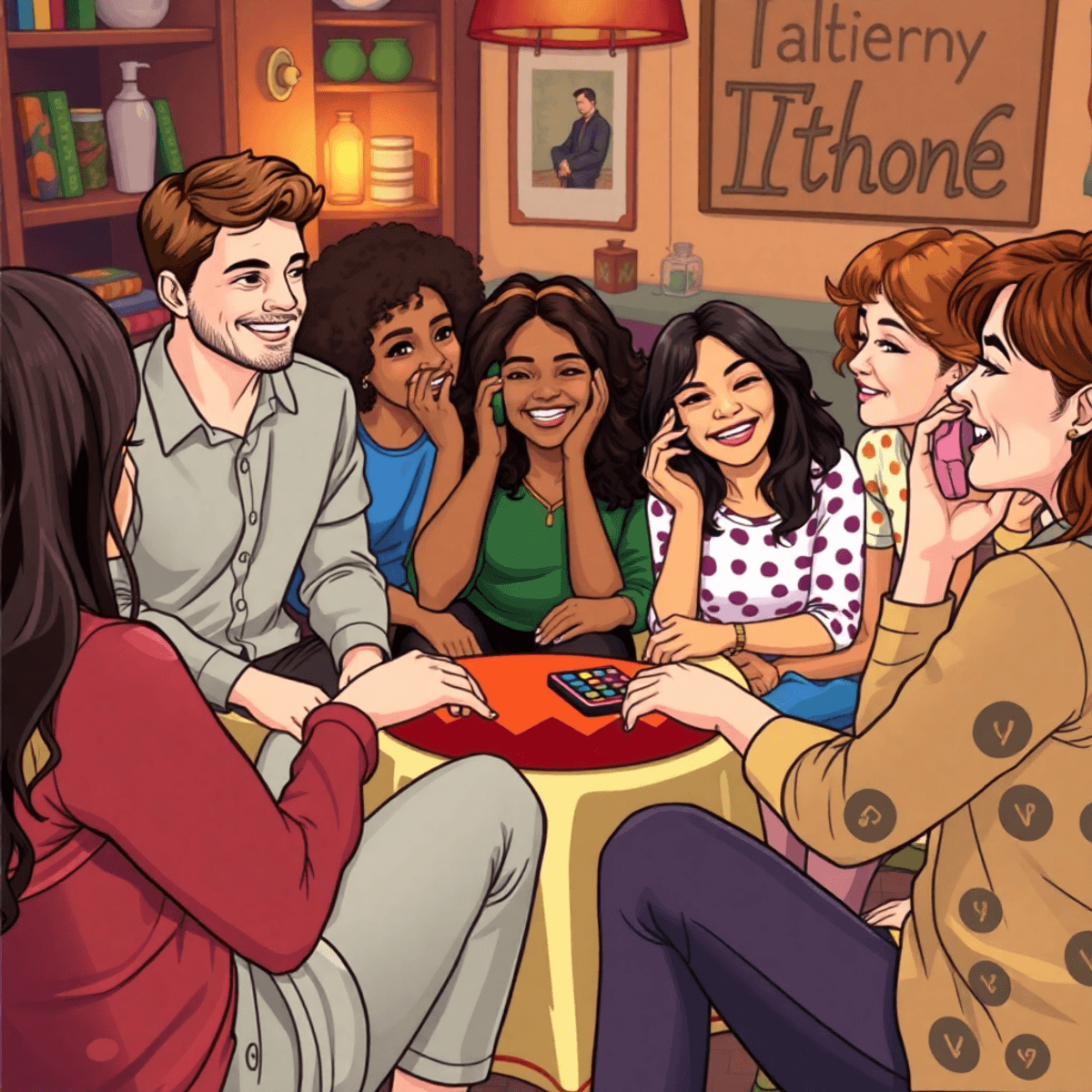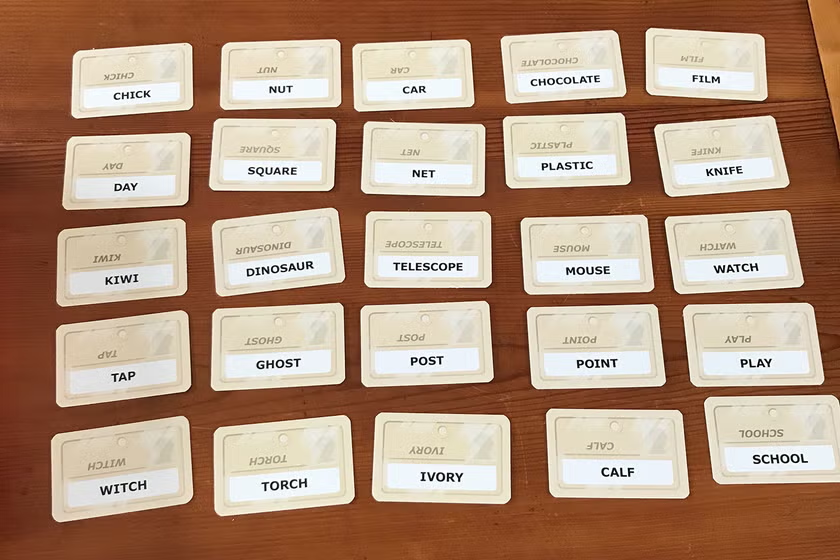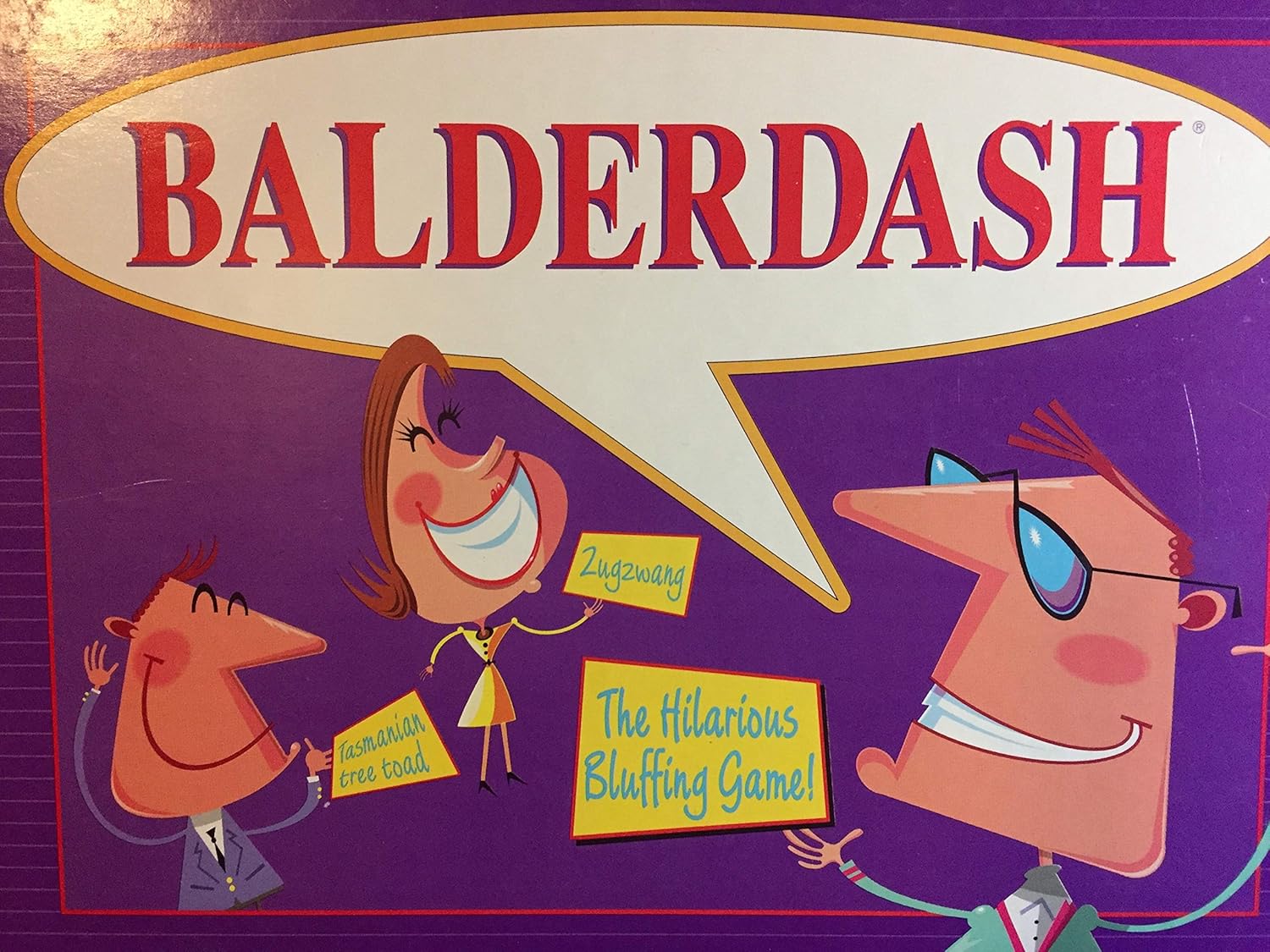
Imagine a room full of laughter as someone desperately acts out The Wizard of Oz while their teammates shout increasingly crazy guesses. This scene, familiar to many, represents the enduring magic of charades, a game that has entertained generations across centuries. Keep reading to explore the rich history of Charades board game.
The Journey of Charades
Charades game has come a long way since its early days in history. Here’s a glimpse into its journey:
- Sophisticated Beginnings: Charades started as an elegant pastime among the elite in French parlors.
- Beloved Party Favorite: Over time, it evolved into a game loved by people of all backgrounds and ages, becoming a staple at parties and gatherings.

Why Charades Endures
So why has charades stood the test of time? Here are a few reasons:
- Bringing People Together: The game’s unique ability to bring people together, fostering creativity and social connection through the art of wordless communication.
- Simplicity: No expensive equipment needed, just willing participants and boundless imagination.
- Memorable Moments: Charades creates memorable moments at gatherings worldwide, bridging social barriers and spanning age groups.
Understanding the rich history behind this timeless game adds depth to every animated gesture and silent performance, revealing how a simple parlor game evolved into an essential element of social entertainment.
The Origins of Charades
Game of Charades history originated in the extravagant salons of 18th century France, where wealthy aristocrats sought refined forms of entertainment for their social gatherings. The French elite invented charades en action – a theatrical word game that showcased their cleverness and acting skills.
How Charades Was Played Back Then
Unlike the version we know today, the original format of charades involved players performing elaborate dramatic acts that included visual puns and witty wordplay. Each syllable of a selected word would be acted out separately, creating a sequence of interconnected performances leading up to the final answer.
Here’s an example of how a typical round might unfold:
- Act 1: Portraying the first syllable
- Act 2: Depicting the second syllable
- Final Act: Combining elements to represent the complete word
The term “charade” itself comes from the Provençal word “charrado,” which means “chatter” or “conversation.” This game reflected the French aristocracy’s love for intellectual pursuits and theatrical arts, serving as both amusement and a display of cultural sophistication.
The Influence of Literature on Early Charades
The early versions of charades often drew inspiration from poetry and literature, with players inventing complex scenarios to represent their chosen words. Unlike today, where silence is a key rule, participants in those days had the freedom to speak and even recite verses during their performances. This literary influence established charades as an elegant pastime that required imagination, knowledge, and dramatic talent.
Charades Takes England by Storm
The arrival of charades in Victorian England marked a transformative period for this French parlor game. The British aristocracy embraced charades with enthusiasm, incorporating it into their sophisticated soirées and evening entertainments. The game found particular favor among the educated elite who appreciated its blend of wit, theatricality, and intellectual challenge.
Literary Influence on Charades
Literary giants of the era played a pivotal role in cementing charades’ place in English society. William Makepeace Thackeray immortalized the game in his masterpiece Vanity Fair, where characters engage in elaborate charades performances at an elegant country house party. The scene captured the essence of Victorian social gatherings and helped popularize the game among readers.
The Brontë sisters brought their own creative flair to charades, often incorporating the game into their family entertainment at the Haworth Parsonage. Charlotte Brontë particularly enjoyed crafting intricate word puzzles for charades, demonstrating how the game evolved to embrace literary sophistication.
Distinctive Features of Victorian Charades
Victorian charades distinguished themselves from their French counterparts through:
- Elaborate costumes and props
- Complex narrative structures
- Multi-act performances
- Literary references and classical allusions
The game became so deeply embedded in Victorian culture that dedicated charades books were published, offering suggestions for performances and helping establish standardized rules for English players.
The Evolution of Charades in Modern Times
At the beginning of the 20th century, charades underwent a significant change in how it was played. Instead of relying on written clues, players embraced a more lively and expressive style that brought social gatherings to life.
The Shift to Performance-Based Charades
Players moved away from using paper clues and instead relied on gestures and mime performances to convey their assigned words or phrases. This new form of acted charades created an exciting atmosphere at parties, with participants eagerly jumping up to act out their clues.
Adapting to Changing Social Norms
The evolution of the game coincided with the shifting social norms of the early 1900s. As formal Victorian parlor gatherings transformed into more casual social events, charades became the ideal choice for entertainment. Its flexibility made it suitable for various settings:
- House Parties: Intimate gatherings where close friends could relax and have fun
- Social Clubs: Regular meetings where members could enjoy entertainment
- Holiday Celebrations: Family-friendly activities during festive seasons
- Community Events: Games that helped break the ice at local gatherings
Spreading Popularity through Social Connections
The popularity of charades grew through word-of-mouth recommendations and social connections. Hosts who experienced the joy of acted charades at one party would enthusiastically introduce it at their own gatherings, creating a ripple effect across different social circles.
The Impact on Players’ Skills
This new interactive format required players to be creative, think quickly, and express themselves physically – skills that aligned with the increasingly relaxed social atmosphere of that time. Players discovered that acting out clues brought about more laughter and involvement compared to the previous written version, solidifying charades’ status as an essential party activity.
Charades After World War I: A New Era Begins
The post-war period marked a significant transformation in how people played charades. The social dynamics of the 1920s brought a fresh perspective to entertainment, with acting charades emerging as the preferred version of this classic game.
The Rise of Team-Based Gameplay
Teams became the cornerstone of charades gameplay, reflecting the collective spirit of the era. Players would divide into groups, fostering friendly competition and strengthening social bonds. This team-based approach encouraged creative problem-solving and quick thinking, as participants worked together to decode their teammates’ performances.
Embracing Silence: The Power of Non-Verbal Communication
Silent performances revolutionized the game’s mechanics. Players embraced the challenge of conveying complex ideas without uttering a word, relying solely on:
- Physical gestures – Using body language to express actions and emotions
- Facial expressions – Conveying reactions and feelings
- Mime techniques – Acting out scenarios and characters
- Visual storytelling – Creating narrative sequences through movement
The art of pantomime became integral to successful charades performances. Players developed sophisticated methods of non-verbal communication, turning simple word-guessing into theatrical displays. This evolution added depth to the game, requiring participants to master both performance and interpretation skills.
Engaging Spectators: The Joy of Watching Wordless Expression
The emphasis on silence created an engaging spectator experience, as audiences watched performers navigate the constraints of wordless expression. This unique challenge transformed charades into an entertaining showcase of creativity and physical comedy, cementing its position as a beloved party activity.
Mastering the Art of Playing Charades: Rules and Gameplay Mechanics
The basic structure of modern charades gameplay follows a set of established rules that create an engaging experience for all participants. Players divide into two teams, with each team taking turns to act out and guess words or phrases within a specific time limit – typically 2-3 minutes per round.
Standard Game Setup:
- One player acts as the performer
- Remaining team members serve as guessers
- A timer keeps track of the round
- Points are awarded for successful guesses
The game’s universal hand signals and gestures form a crucial communication system:
Essential Charades Gestures:
- Tugging ear: “sounds like”
- Holding up fingers: number of words
- Drawing rectangle: movie/TV show
- Book opening motion: book title
- Pointing to wrist: time period
- Rolling hands: longer version of word
Props remain strictly forbidden during performances, forcing players to rely solely on body language and facial expressions. The acting player must maintain complete silence throughout their performance, adding an extra layer of challenge to the game.
Categories often include movies, books, songs, famous people, or everyday actions. Teams can customize these categories based on their preferences or knowledge base. A scoring system tracks successful guesses, with points typically awarded based on the speed of correct answers.
Charades Through The Lens Of Popular Culture: Adaptations And Variations Over Time
Television transformed charades into a mainstream entertainment phenomenon through popular game shows like Password and Hollywood Game Night. These shows introduced exciting elements:
- Lightning rounds with strict time limits
- Celebrity participants adding star power
- Point-based scoring systems
- Musical accompaniment
- Enhanced production values
The digital age sparked creative variations of traditional charades. Mobile apps like Heads Up! revolutionized gameplay by eliminating the need for physical cards and expanding category options.

Cultural adaptations have enriched the game’s appeal across different regions:
- Bollywood Charades – Indian versions featuring popular movie scenes and dance moves
- Anime Charades – Japanese adaptations focusing on manga and anime characters
- Disney Charades – Family-friendly versions centered around beloved animated classics
Theme-based variations have become increasingly popular at specialized events:
- Book club meetings with literary character reenactments
- Movie nights featuring iconic film scene performances
- Holiday parties with seasonal word lists
- Corporate team-building exercises using industry-specific terms
The game’s flexibility allows for constant innovation. Recent adaptations include virtual charades platforms for remote play, enabling friends and family to enjoy the game across different locations while maintaining its interactive spirit.
Playing Charades Today: The Cultural Significance And Enduring Appeal Of This Timeless Game
The enduring charm of charades lies in its ability to transform ordinary gatherings into memorable experiences. At modern family reunions, charades serves as a natural icebreaker, bridging generational gaps and creating shared moments of joy. Grandparents, parents, and children find common ground in the simple act of acting out clues, making it a cornerstone of family entertainment.
The Educational Benefits of Charades
The game’s educational value extends beyond mere entertainment. Research from the National Association for the Education of Young Children suggests that interactive games like charades help develop:
- Non-verbal communication skills
- Quick thinking and creativity
- Public speaking confidence
- Active listening abilities
Charades in the Digital Age
Modern technology has enhanced rather than diminished charades’ appeal. Digital word generators and themed apps provide endless inspiration for players while maintaining the game’s core interactive nature. Corporate team-building events now regularly incorporate charades to build trust and improve workplace communication.
The Accessibility of Charades
The game’s accessibility remains unmatched – requiring no special equipment or complex setup makes it an ideal choice for impromptu gatherings. Whether played in living rooms, classrooms, or office break rooms, charades creates an inclusive environment where language barriers dissolve and shared laughter becomes the universal language.
Charades as a Catalyst for Connection
This timeless activity continues to strengthen social bonds across different settings. From breaking the ice at neighborhood block parties to entertaining guests at wedding receptions, charades maintains its position as a reliable catalyst for genuine human connection in an increasingly digital world.
Conclusion: The Enduring Legacy of Charades and Its Promising Future
Charades game has a rich history, evolving from 18th-century French parlors to modern-day living rooms. This game has shown an incredible ability to adapt and thrive across generations. It has created countless memories, strengthened relationships, and brought joy to gatherings worldwide.
Exciting Possibilities for the Evolution of Charades
The digital age opens up exciting possibilities for charades to evolve:
- Virtual Reality Integration: Imagine acting out clues in immersive virtual environments
- AI-Enhanced Gameplay: Smart devices could generate personalized word banks and track player performance
- Global Connected Play: Technology could enable real-time charades matches between players across continents
- Augmented Reality Features: AR overlays might add visual elements to enhance performances
These technological advancements won’t replace the game’s core appeal – the human connection, creativity, and spontaneous laughter that make charades special.
The Power of Charades
The legacy of charades lies in its power to bring people together, transcend language barriers, and create shared experiences that last a lifetime. As we look ahead, charades will continue to evolve while maintaining its essential role as a beloved party staple.
Charades game history is very interesting, but if you want to learn more about history of party and social board games check our in depth guide – From Parlors to Parties: The Evolution of Social Board Games.





